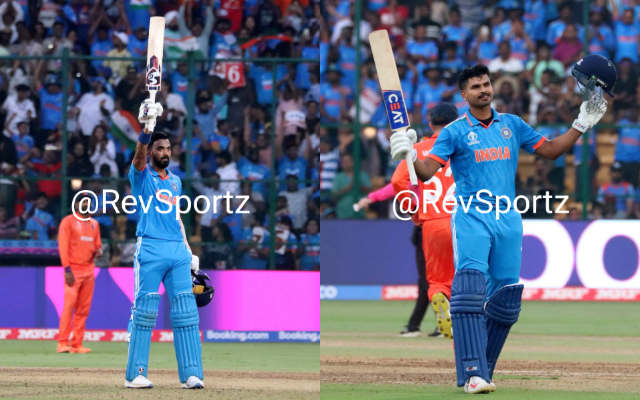
Bharath Ramaraj at the Chinnaswamy
It is Diwali season all over India. Boom! Dhoom! Rat-A-Tat! Dabbb! One after another, firecrackers lit up the country’s cities and villages. Inside the Chinnaswamy Stadium, too, it felt as if Diwali was being celebrated, but of a different kind. Different streams of colour bursting forth outside were matched by the pizzazz of KL Rahul and Shreyas Iyer’s stroke-play.
The explosive din reached its crescendo in the last few overs of the Indian innings. By then, even the spirited Netherlands unit seemed to have lost its vigour amid all the bedlam. While bowling to Iyer, Logan van Beek tried slower deliveries and the line was outside off. He also zoomed one on the sticks before reverting back to Plan A – keeping it away from the hitting zone. All that happened was the Kookaburra ball ended in different directions – long-on, midwicket and covers.
It was a kind of jugalbandi at the end as Rahul himself smacked four sixes to Iyer’s five, which included two hits that cleared the boundary rope in the final over. He can wear different hats according to the situation of the game and also has the uncanny knack of bisecting the minutest of gaps in the field. Rahul, who has had his share of detractors, is also playing with a sense of playfulness at the crease. For a while, that seemed to be missing from his game.
There was another side to the duo’s batting. Just take up a pair of binoculars and you could see the contrast in their styles. Rahul belongs to the old-school, taking a front-foot stride at every given opportunity. At the other end, Iyer is a quintessential modern-day batter – he has a back-foot trigger and aims to clear the front leg. This makes it difficult for the bowlers to settle into a groove as the methods are different.
There was so much more to talk about the Chinnaswamy than just the mundane technicalities of the game. By the fag end of the innings, those monstrous hits seemed to be in tune with the roars of free-spirted fans. Most of the spectators were so transfixed by the action that they weren’t even seated on their respective chairs. Some were dancing wildly, and a few others resorted to whistling. The chants of “Iyer, Fire” and “Rahul, Rahul” also grew louder.
It was perhaps hard to believe, but for a few minutes, there was also a bit of lull at the Chinnaswamy. Yes, there was stunned silence when Virat Kohli was dismissed. Until then, there was heightened anticipation that Kohli would break Sachin Tendulkar’s record for most tons in ODIs.
Right from the time Kohli walked down the steps, to every run he scored, Virat was ‘King Kohli’ for the spectators. Even when his bottom hand seemed to get tightened up early on in his innings, his mistimed shots were met with applause. After all, Kohli also plays for the Bengaluru franchise, RCB. And then, he reached the half-century mark.
Right at that moment, the mind travelled back in time to September 1998 when Tendulkar broke Desmond Haynes’ then-record of 17 ODI hundreds in Bulawayo. The memories are too hazy to recall more than a few shots from that knock. But when Tendulkar broke the record, it was met with lukewarm response from the spectators. Probably those at the stadium didn’t know the significance when Tendulkar raised his bat.
Just as this writer was gathering a few thoughts from a game played 25 years ago, Kohli was castled by Roelof van der Merwe, his former RCB teammate. Such is the adoration for Kohli in Bengaluru that Karnataka’s very own Rahul didn’t get anywhere near the same kind of claps and whistles as he made his way out to the middle.
India’s thoroughbred performance wasn’t just restricted to sizzling batsmanship from Rohit Sharma, Kohli, Rahul and Iyer. There was yet another clinical show from the bowling unit too. Four of the five mainstays of the bowling attack shared most of the scalps, although the in-form Mohammed Shami couldn’t pick up a wicket. The likes of Kohli, Rohit and Shubman Gill also rolled their arms over, with Kohli and Rohit bagging a wicket each.
It feels as if India can do no wrong at the moment. The five-man attack is functioning like a fleet of Rolls Royce cars – very smooth and powerful. Opponents also might be scratching their heads and wondering how to get these batters out.
Some 1000 km away, in Mumbai, the New Zealand think-tank would know they have a herculean task ahead of them as they take on India in a semifinal at the Wankhede. Rather than worrying about the big names in the Indian team, it would be prudent for New Zealand to maximise their own strengths. Having watched New Zealand over a few decades, expect them to do just that.



